Soltek K8TPro-939: Moving A64 to 939
by Wesley Fink on October 28, 2004 12:05 AM EST- Posted in
- Motherboards
BIOS: Soltek K8TPro-939

Soltek uses Phoenix-Award BIOS, which will be a familiar interface for most users.

Most of the options of interest to overclockers are contained in the Frequency/Voltage Control menu. This includes CPU speed, AGP Asynchronous (Fixed) select, CPU ratios, and CPU/DIMM/AGP/VDD (2.5V) voltage.
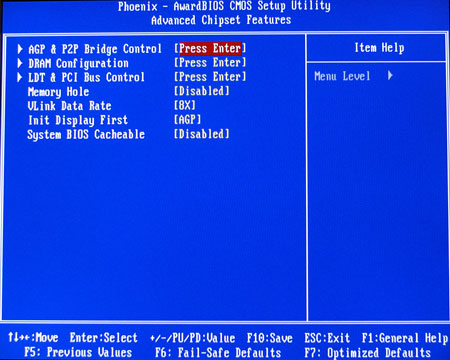
The enthusiast settings not found in Frequency/Voltage Control can be found in Advanced Chipset Featrures. HT ratios to 1 GHz are available in the LDT & PCI Bus Control submenu.
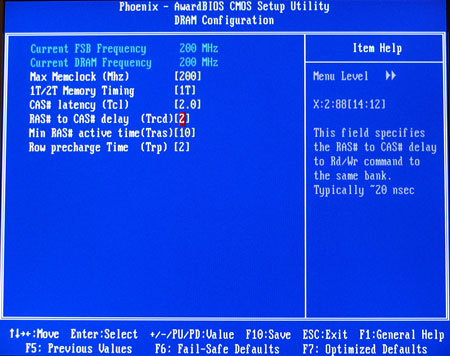
The DRAM Configuration submenu contains a full range of memory settings. The shipping K8TPro-939 BIOS had adjustments for just CAS timings, while the 10/26 Beta BIOS added a complete selection of memory adjustments.
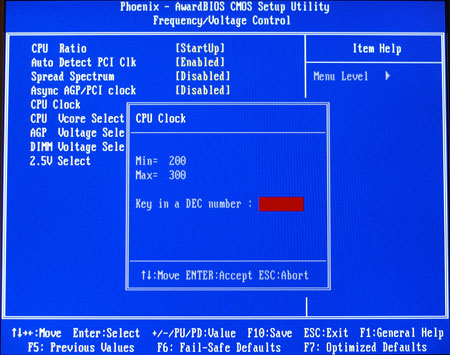
The CPU can be adjusted over an adequate, if not exciting, speed range from 200MHz to 300MHz in 1MHz increments. We prefer a wider range on Athlon 64 boards, since the A64 allows choosing lower CPU ratios. However, as you will see in overclocking, the adjustment range is a moot point in the current Soltek design.
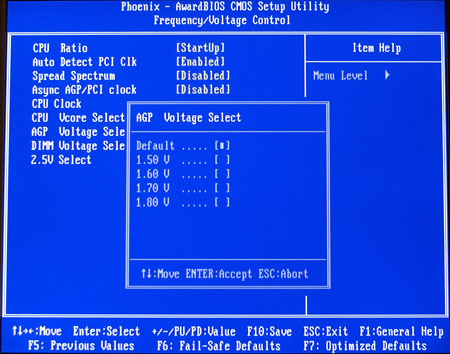
The Asynchronous AGP/PCI Clock can be set to Enabled (fixed 66 AGP/PCI frequency) or Disabled. Unfortunately, as you will see in the OC pages, this function does not appear to work in the Soltek BIOS that we tested.
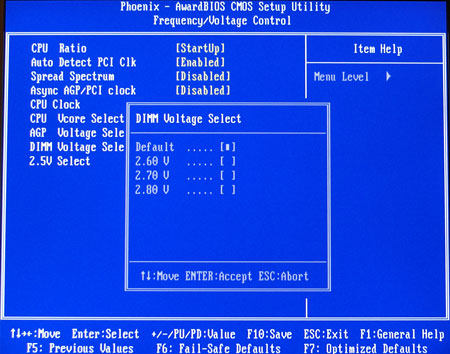
Memory Voltage can be adjusted to 2.8V, which is OK. A range to 3.0V to 3.2V would have been much more useful for those who push the performance of their system.

The other part of high FSB clocking is CPU ratios or multipliers. The Soltek provides a wide range of 4X to 20X, with adjustments in whole multipliers only. Keep in mind that while all Athlon 64 chips can be downclocked with lower ratios, only the FX chips are completely unlocked and can be set to higher than stock ratios. We confirmed that the ratios do work as they should on the K8TPro-939 board.

vCore can be widely adjusted from 0.8V to 1.7V. This should satisfy all, but the most aggressive phase-change overclockers.
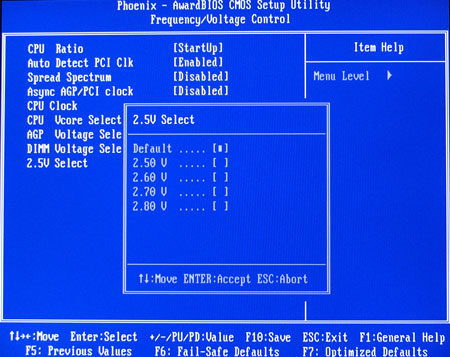
VDD voltage can be adjusted from the default 2.5V up to 2.8V.
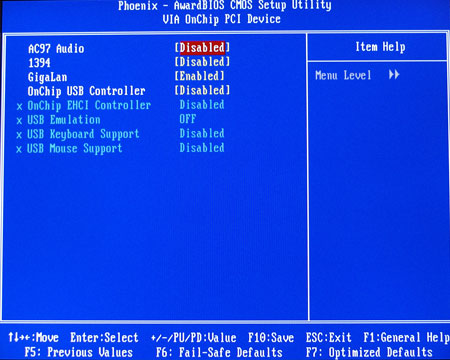
With all of the integrated features of the K8TPro-939, you will spend a lot of time in the Integrated Peripherals menu.
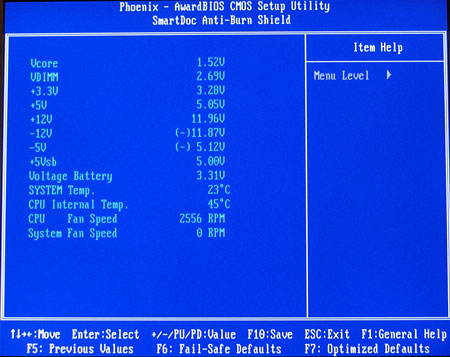
Soltek calls their PC Health function SmartDoc Anti-Burn Shield. Here, you can monitor fan speeds and voltages. For those interested in the AMD K8 Cool'n'Quiet, the adjustments can be found in the Power Management Setup menu.










21 Comments
View All Comments
WT - Monday, April 11, 2005 - link
A Soltek response in the forums:http://forums.anandtech.com/messageview.aspx?catid...
horsefly24 - Tuesday, January 18, 2005 - link
Here is an update to the Soltek SL-KT8 Pro motherboard to the DDR400 bios problem http://www.soltek.de/soltek/download/download_all....bob661 - Tuesday, November 2, 2004 - link
#16I have one of those boards but haven't tried the hothardware.com suggestion. I don't feel comfortable with cranking my HT up to 230 just to see if the damn locks work. Also, I'm going to try lowering the HT multiplier to see if that might enable the lock. I just wish Anand was a bit more precise in explaining how he got his lock to work.
Schro - Sunday, October 31, 2004 - link
>We suspect that this generates enough US volume>that Soltek must wonder what the real value of
>a US distributor would be.
Soltek HAD an exclusive US distributor, a company doing business as "Soltek USA". They were one of the best distributors that I have ever dealt with (sent plenty of promo packs ;)... ). They called it quits because Soltek Taiwan sold direct to the Egg, who was supposed to be purchasing from the US distributor. This undercut Soltek USA's business, etc etc. Hence, they have been gone for over a year now.
Wesley Fink - Thursday, October 28, 2004 - link
#16 - We also tried 233 on the Soltek which also did not work.As for 939 reviews, the Gigabyte GA-K8NS Ultra-939 is a lower cost version of the GA-K8NSNXP-939, which we have already reviewed. Since we have already reviewed the flagship Gigabyte 939, we will not be reviewing the lower members of the same family. The same applies to the lower-featured versions of some MSI boards.
The Asrock is based on the Uli chipset, and it's a possible review for the future. However, with PCIe boards coming, an AGP/PCI board with both sockets 754 and 939 probably won't find a slot in our review calendar.
thebluesgnr - Thursday, October 28, 2004 - link
Another great review, thank you Wesley.About PCI/AGP lock:
"However, no matter what lower ratio we chose, the highest CPU clock setting that we could achieve with stability was 228"
Some VIA K8T800 Pro boards without working locks have PCI/AGP dividers for 233 and 266MHz "FSB". Have you tried going from 228 directly to 233 on this board?
About that, I remember the MSI K8T Neo2 review. You wrote:
"We have been assured that shipping K8T Neo2 boards will have working PCI/AGP locks and we are passing this information to you."
I've seen many people complain that their boards do not have working locks; I've read this in a review (HotHardware.com):
"From 200MHz to about 212MHz, the K8T seemed to function normally. But at speeds from 212MHz through 230MHz, the board occasionally wouldn't POST. Speeds above 230MHz consistently worked, but we weren't very confident in our particular board's overclocking ability."
It would be great if you guys could get one of these from retail channel (and not directly from MSI) to check this out and update that review.
Anyway, with this Soltek review there are only two socket 939 boards listed in newegg not reviewd by AnandTech: ASRock K8 Combo-Z (cheapest s939 mobo, by $31) and Gigabyte GA-K8NS Ultra-939. If you could let us know if you'll review them I'd appreciate it. ;)
Gnoad - Thursday, October 28, 2004 - link
If there eventually is a BIOS update to this board that fixes the AGP lock, anandtech really needs to do a second review, or at least an update. This board looks like my future purchase if there ever is a updated bios.KrazyDawg - Thursday, October 28, 2004 - link
With the newer Asus motherboards, you won't have a problem with resetting the CMOS. There's an option to load defaults in the BIOS and if you're overclocking with an Asus motherboard and it fails to POST, it will reset the values to the ones previously used before you made the adjustment.Aikouka - Thursday, October 28, 2004 - link
#3, that floppy location is a pain, because if you ever have to get to the BIOS reset jumper, it makes it a lot harder, especially if you have a large case. I have a Thermaltake Xaser III V2000A, and it's a fairly large case. So a lot of my cables are stretched as far as they can go (especially from the PCI IDE card) and the floppy cable is no exception. At one point, I wanted to reset the bios, because the board was acting funny, and this was made extremely difficult by the location of the floppy connector and the bios reset jumper's location. One of the two should be moved to allow easier access. Also, the front panel connectors (Power switch, etc.) are below that, putting even more tight cables in the way.Looking at the picture, the JBAT jumper is located right beside the floppy cable, making it a pain to work with anyway.
Just like on the SL-K8ANE2-GR the purple doesn't suit it very well.
Soltek is really good with customer support, though. I was having problems with my board and they even sent me a beta BIOS to try out. Responses came back within 3 hours (usually around 1 hour.)
Wesley, I don't know chip prices off-hand or anything, but I can't see how VIA's solution would add a great cost to the board when Chaintech sells a VIA ENVY pci sound card, which retails for $25 (retail) on newegg.
UnderScore - Thursday, October 28, 2004 - link
Wesley,I like that AT includes content creation & encoding tests and I realize that games are popular repeatable ways to stress test a system. Perhaps these MB reviews could be less focused on game performance and more on the MB's subsystems? Why not prove that the Gigabit LAN will be slower on the PCI bus rather than guessing that it will likely be slower. Am I to assume that USB, Firewire, Onboard digital I/O etc by default are all working perfectly if they are not mentioned? Testing & reporting of such items would make AT's testing methodolgy more balanced since just like #4 & #9 mentioned, not everyone is an overclocker & similarly not everyone plays games regularly (esp FPS).
In closing, I thank you for all the work that you do & I hope you take this constructively as I had not intended to slam you or AT.
Thanks,
James